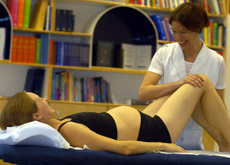What

The approach used is osteopathy. Within this discipline are:
• Evaluation
• Diagnosis
• Soft tissue massage and manipulation
• Muscle and joint stretching and mobilisation
• Electro-therapy and ultrasound therapy
• Postural assessment and advice
• Exercise prescription and advice
Whilst the interventions are manually applied to the outside of the body, the effects reach into the body via the anatomical connections of the body’s tissues.
If you would like to read more about osteopathy, please click here to be directed to the official General Osteopathic Council website.
When you visit the osteopath for the first time, you will be asked a variety of questions about any problems you currently have, as well as some background health related information. This helps the practitioner start to gain insight into your general health, and how your body copes with internal and external stresses.
The osteopath will then want to examine your body framework. Usually patients are asked to remove outer clothes at this stage. The actual examination will depend on the issues raised while talking to you. It may include some neurological tests, or circulatory tests, for example. It will always include palpation, which is a way of feeling the body tissues to identify problem areas. The areas around the spine, and local to where you experience symptoms, are likely to be palpated.
The osteopath will then discuss their findings with you, and tell you what treatment they feel is most likely to benefit you. The detailed questions and examination help the practitioner to tailor an individual treatment plan. It may involve you attending several sessions. The particular techniques are chosen according to your needs, as well as your preference (if you do not want joint manipulation – the ‘crack’ - that can be accommodated).

